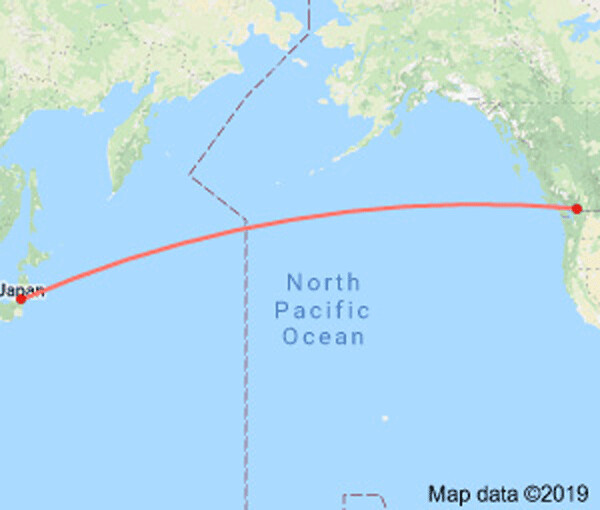News & Articles
Browse all content by date.

The Japanese fishing community and nuclear watchdog groups are raising alarms over government plans to dump into the Pacific over 1-million tons of highly contaminated waste water from three devastated nuclear reactors at Fukushima.
The London Telegraph reported last October that Japan’s “plan to release the approximately 1.09 million tons of water currently stored in 900 tanks … has triggered a fierce backlash from local residents and environmental organizations, as well as groups in South Korea and Taiwan fearful that radioactivity from the second-worst nuclear disaster in history might wash up on their shores.”
Greenpeace issued a report Jan. 22, 2019 condemning the plan, reminding the public that the owners/operators of Fukushima — Tokyo Electric Power Co. (TEPCO) — admitted in 2018 that its waste water treatment system (the Advanced Liquid Processing System or ALPS) had failed. “Despite the much-vaunted Advanced Liquid Processing System (ALPS) plant at Fukushima, Tepco has confirmed that levels of strontium-90 are more than 100 times above legally permitted levels in 65,000 tons of water that have already been through the ALPS system,” the South China Morning Post reported last January.
Outrage within the fishing community was palpable during a series of public hearings last year which were designed to convince skeptical observers that pouring more radiation in the Pacific is a good idea. The magnitude-9 earthquake, and the tsunami it caused on March 11, 2011, left more than 27,500 people dead or missing in northeast Japan, and triggered the largest release of radioactivity to the ocean in history.
Dumping Radioactive Water Poisons Fish
Since Fukushima’s triple catastrophe — earthquake, tsunami, and radiation plumes — there has been relentless news of seafood contamination. On Feb. 2, 2019, the Japan Times reported that radioactive cesium far above the legal limit was detected in fish caught off Fukushima, according the Fukushima Prefecture’s Fishery Cooperative Association. Skate, a variety of ray, that was caught over 180 feet deep, was found with 161 Becquerels-per-kilogram of radioactive cesium-137, exceeding the allowable limit of 100.
However, since cesium-137 is a reactor-borne element not found in nature, the established 100 Bq/kg limit is arbitrary. None whatsoever should be “permitted” because any internalized cesium-137 can potentially cause health problems. Any cesium that we eat and which is not excreted, adds to previously ingested radioactive materials. Radioactive water is continuing to flow into the Pacific Ocean from the site of three mangled reactors at a rate of around 2 billion Becquerels a day, according to a 2018 Japanese study, the Japan Times reported March 29, 2018.
Cesium-137 has been found in Canadian fish as well. The Haida Gwaii Observer in Queen Charlotte, B.C. reported last March 16, 2018 on a press release issued by Krzysztof Starosta, a chemist at Simon Fraser University’s nuclear science lab. Starosta reported that in his study, cesium-137 “levels found in both the salmon and soil samples remained below Canada’s safety guidelines, posing minimal health risk to B.C.’s salmon and human populations.” The use of the word “minimal” by Starosta is a trivialization of “some” risk, especially when considered in view of the cumulative effect of eating contaminated fish over a lifetime.
Likewise in the United States, in April 2014 the Oregon Statesman Journal reported on a study by Oregon State University that found that Fukushima radiation in albacore tuna caught off the Oregon coast tripled after the 2011 meltdown. “You can’t say there is absolutely zero risk because any radiation is assumed to carry at least some small risk,” said lead author, Delvan Neville, in OSU’s Department of Nuclear Engineering and Radiation Health Physics. In October of 2012, Albacore tuna caught off Washington and Oregon and Blue fin tuna off of California were also found contaminated with Fukushima cesium.
Since 2016, TEPCO has repeatedly claimed — and news reports repeatedly noted — that its “advanced [ALPS] processes had reduced the cancer-causing radioactive contaminants” such as strontium-90, iodine-129 and ruthenium-106 in the water “to non-detectible levels.” Then, last October, the Telegraph noted, “[T]he ALPS has consistently failed to eliminate a cocktail of other radioactive elements, including iodine, ruthenium, rhodium, antimony, tellurium, cobalt and strontium.” According to the Telegraph, “Iodine 129 has a half-life of 15.7 million years and can cause cancer of the thyroid; ruthenium 106 is produced by nuclear fission and high doses can be toxic and carcinogenic when ingested.”
“In late September [2018], Tepco was forced to admit that around 80% of the water stored at the Fukushima site still contains radioactive substances above legal levels…” the Telegraph said.
TEPCO has admitted for example that in several of the storage tanks, levels of deadly, long-lived strontium-90 are 20,000 times the allowable limit levels set by the government. Pouring this carcinogenic brew into the sea is reckless endangerment of the commons. There ought to be a law.
| Tweet |

